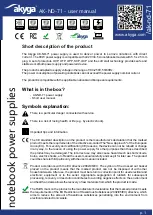
Page 57
EA Elektro-Automatik GmbH
Helmholtzstr. 31-37 • 41747 Viersen
Germany
Fon: +49 2162 / 3785-0
Fax: +49 2162 / 16230
www.elektroautomatik.de
EL 9000 B 15U/24U Series
3.6
Alarms and monitoring
3.6.1
Definition of terms
There is a clear distinction between device alarms (see
), such as overvoltage protection,
and user defined events such as
OCD
(overcurrent detection). Whilst device alarms primarily serve to protect the
connected DC source by switching the DC input off, user defined events can do the same (action = ALARM), but
can also simply give an acoustic signal to make the user aware. The actions driven by user defined events can
be selected:
Action
Impact
Example
NONE
User defined event is disabled.
SIGNAL
On reaching the condition which triggers the event, the action
SIGNAL
will
show a text message in the status area of the display.
WARNING
On reaching the condition which triggers the event, the action
WARNING
will show a text message in the status area of the display and pop up an
additional warning message.
ALARM
On reaching the condition which triggers the event, the action
ALARM
will
show a text message in the status area of the display with an additional alarm
pop-up, and additionally emit an acoustic signal (if activated). Furthermore
the DC input is switched off. Certain device alarms are also signalled to the
analog interface or can be queried via the digital interface.
3.6.2 Device alarm and event handling
Important to know:
•
The current drained from a switching power supply or similar sources can be much higher than
expected due to capacities on the source’s output, even if the source is current limited, and
might thus trigger the overcurrent shutdown OCP or the overcurrent event OCD of the electronic
load, in case these supervision thresholds are adjusted to too sensitive levels
•
When switching off the DC input of the electronic load while a current limited source still sup
-
plies energy, the output voltage of the source will rise immediately and due to response and
settling times in effect, the output voltage can have an overshoot of unknown level which might
trigger the overvoltage shutdown OVP or overvoltage supervision event OVD, in case these
thresholds are adjusted to too sensitive levels
A device alarm incident will usually lead to DC input switch-off, the appearance of a pop-up in the middle of the
display of the master unit and, if activated, an acoustic signal to make the user aware. The alarm must always
be acknowledged. If the alarm condition no longer exists, e.g. the device has cooled down following overheating,
the alarm indication will disappear. If the condition persists, the display remains and, following elimination of the
cause, must be acknowledged again.
►
How to acknowledge an alarm in the display (during manual control)
1.
If the alarm is indicated as a pop-up, tap
OK.
2.
If the alarm has already been acknowledged, but is still displayed in the status area,
then first tap the status area to display the pop-up, and then acknowledge with
OK.
In order to acknowledge an alarm during analog remote control, see
„3.5.4.3. Acknowledging device alarms“
. To
acknowledge in digital remote, refer to the external documentation “Programming ModBus & SCPI”.
















































